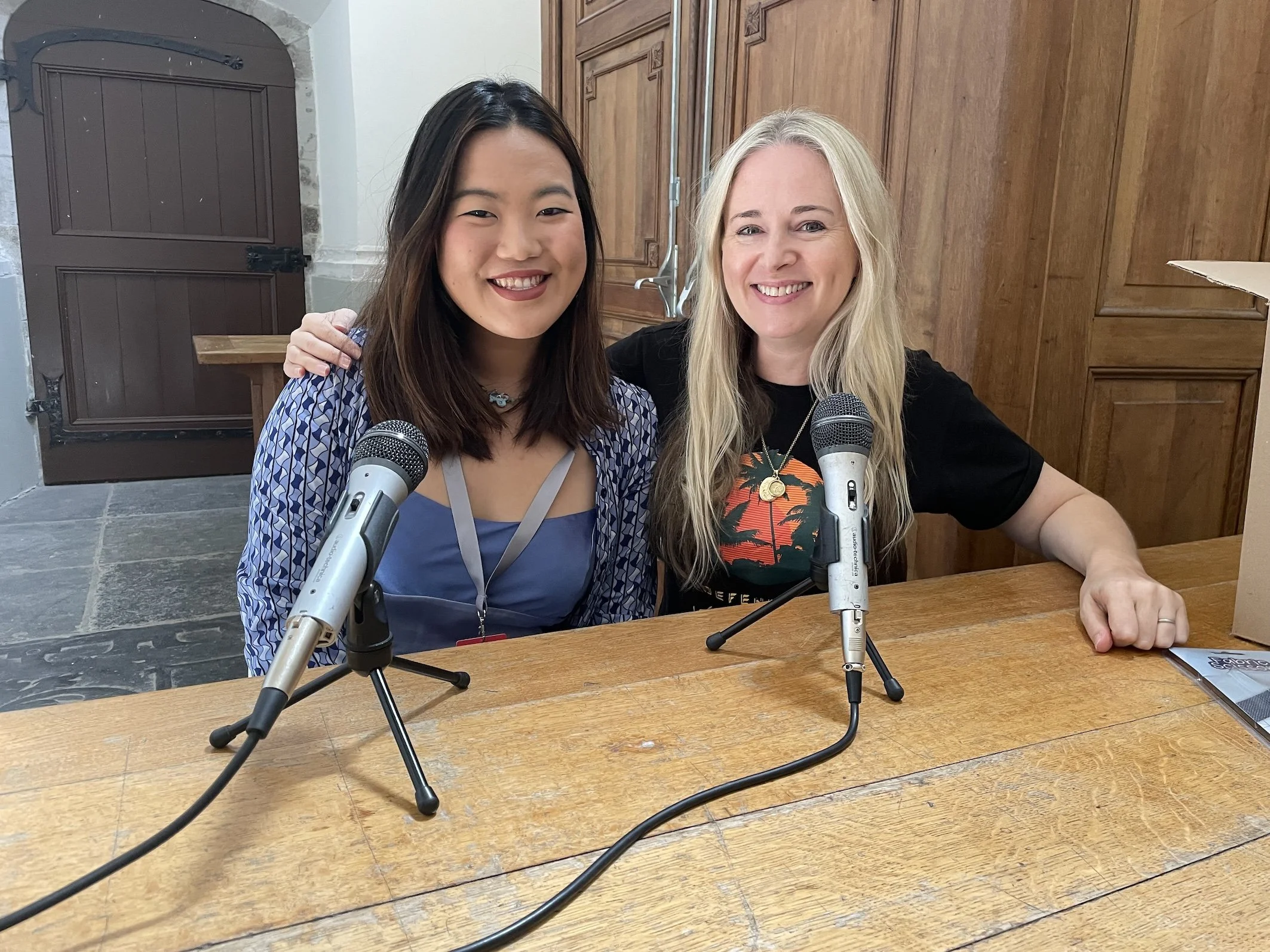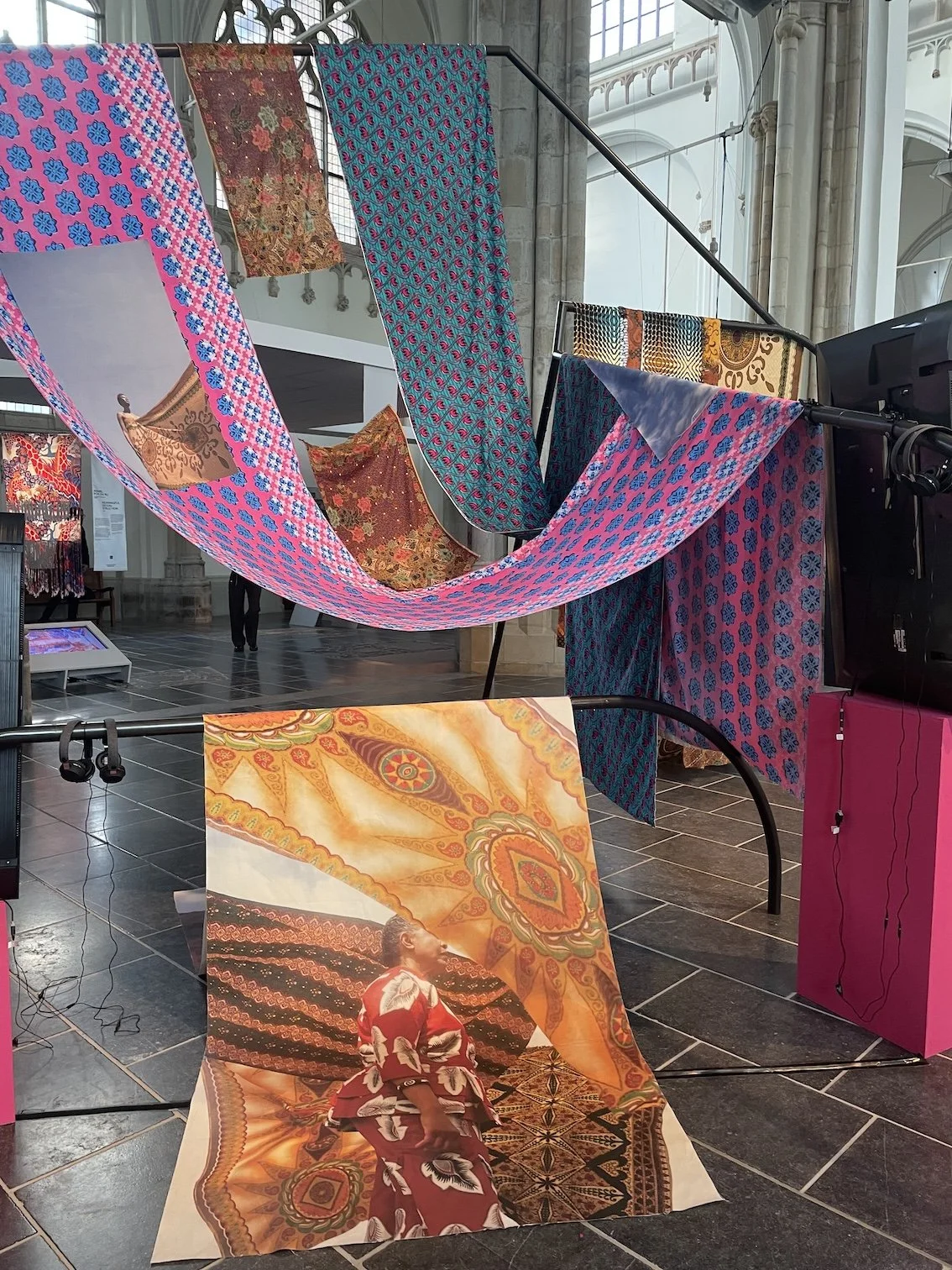Empathy, kindness, wellbeing, caring, sharing, repairing - not traditionally the first words that spring to mind when I say "FASHION!" But things are changing. Are we moving towards a new paradigm where who cares, wins? If we accept that the old ways (overproduction, exploitation, rampant shareholder capitalism, waste) don't serve us, why not redesign the whole thing along radical new lines? What might that look like?
Bodies That Make, Bodies That Consume by Santiago Útima, Siviwe James, Widi Asari and Riyadhus Shalihin, as seen at State of Fashion 2022.
If you're intro underground fabulousness pushing disruptive fashion forwards, you might have noticed that in Arnhem, the Netherlands, the State of Fashion Biennale 2024 happened over the summer.
This year's theme was 'Ties that Bind', and explored: ‘dismantling tradition’, ‘political bodies’ and ‘the fabric of shelter’. Curators Rachel Dedman and Louise Bennetts invited a host of designers, academics and creatives - including Lukhayno Mdingi, Sun lee, Maison ARTC, and Buziga Hill’s Bobby Kolade (who was on Episode 210 of Wardrobe Crisis) - to respond to the questions: How are artists from the Global South addressing & contesting colonial legacies embedded in clothing and cloth? How are designers evolving inherited traditions, and engaging with the urgencies of our time?
This Episode was recorded at the last biennale, in 2022 - and saved up because some of these stories are in Clare’s latest book Wear Next.
Says Clare: “Come back in time with us to that glorious summer. These conversations explore timeless themes. If anything, what we discuss feels even more relevant today. Also, if you've been feeling a bit blah about conventional fashion weeks and events, this should shake you up. It proves that not everything has to be about business and brands!”
WHO CARES? With the central theme Ways of Caring, the 2022 State of Fashion biennale set out to discover ways to make the fashion industry more sustainable and caring. Participants were chosen from an open call.
With seven programme parts, over five weeks, and featuring more than 70 designers, artists and makers from all over the world, and the public - the big idea was to “work on the broken relationship between the production of fashion and the wearer”. Who cares wins!
Iris Ruisch
YOU ARE LISTENING TO…
IRIS RUISCH is the director of the State of Fashion Foundation (formerly head of program). Iris graduated from ArtEZ in 1998, after which she worked as a designer for several fashion houses. She was heavily involved in talent development for many years as Senior Design Consultant & Talent Scout at HTNK, and then became Creative Director of Amsterdam Fashion Week.
Orsola de Castro. Image: Eva Broekema
ORSOLA DE CASTRO , co-founder of Fashion Revolution, is a London-based Italian designer, educator and activist who, as part of Fashion Open Studio, co-curated the 2022 biennale. Her book, Loved Clothes Last, is highly recommended. Listen to Orsola on Episode 69. Discover Esthetica here.
SIVIWE JAMES is a South African fashion researcher, practitioner and former menswear designer whose work seeks to elevate the stories, knowledges and experiences of Xhosa people. More here.
Siviwe James
EUNICE PAIS is a Portuguese photographer “who aims to participate positively in areas such as ethical fashion, fashion photography, social and environmental awareness”. She is the founder of Pais Agency.
ANABEL POH is a material strategist, visual storyteller and innovator specialised in textiles based in the Netherlands. Born and raised in Singapore, she studied at Design Academy Eindhoven and is currently studying a masters in Innovative Textile Development. More here.
Anabel with Clare, recording in St Esebius Church
KATY MASON and JASMINE FEBBRARO are two of the British upcyclers behind Soup Archive. Punk disrupters, they make work from literal trash they find in the street, in bins, in the gutter. Not for them, fancy-schmancy designer deadstock - they’d rather turn a discarded crisp packet into a the ruffle on a shirt sleeve, or some mattress springs into a sculptural accessory.
Katy is a former artist-in-residence at McQueen’s Sarabande Foundation, known for her intricate, sensitive and tangled aesthetic.
Jasmine Febbraro (left) & Katy Mason
NOTES
STATE OF FASHION is an international fashion platform that connects pioneers in fashion design, research and business, and shares their ideas and innovations with the world. Every two years, this culminates in a biennale event in Arnhem, Netherlands. The 2022 BIENNALE was co-curated by two groups, Not Enough Collective - made up of three south American fashion disruptors: Andrea Chehade Barroux, Mari Cortez and Marina Sasseron de Oliveira Cabral - and the team from Fashion Open Studio.
Deep dive into the program here.
Bodies That Make, Bodies That Consume by Santiago Útima, Siviwe James, Widi Asari and Riyadhus Shalihin, as seen at State of Fashion 2022.
ABOUT THE WORK Bodies That Make, Bodies That Consume “reflects on material residues as workers' truth, the deep-rooted voids of erasure of textile and clothing manufacture workers’ conditions. Residue becomes displaced memory, traces of evidence and ruins connected to the process of industrialisation of countries of the global south: Colombia, South Africa and Indonesia. This is evidence that industrialisation and excessive (if not inhumane) labour conditions on local peoples has acted as a form of colonisation of land/bodies/environments and experiences. The co-creators hope to bridge the gap between ‘the hands that make’ and the ‘bodies that consume’ with a desire of addressing the various emotional and physical situations labourers endure.”
LISOF, the well regarded Johannesburg fashion school, is now known as STADIO. Find them here.
XHOSA is a Bantu ethnic group native to South Africa.
Eunice Pais, Anabel Poh & Tra My Nguyen
amidst the threads, our names become. 2022
Anabel with Eunice’s mum. amidst the threads, our names become. 2022. Image via https://stateoffashion.org/
MOZAMBIQUE was colonised by the Portuguese, gaining independence in 1975. CAPULANA is the Mozambiquan name for African WAX CLOTH, which is, confusingly, is also referred to as Dutch Wax Cloth. You’ll hear Eunice say she can’t be sure how capaluna in her photographs was made - this is why:
The way it’s produced is complicated by the history of colonialism, particularly involving the Dutch via Indonesia, which is known for its beautiful, hand-done batiks. The Europeans liked these wax print designs, so began to copy them, automating the process to make it cheaper. One company, the now very famous Vlisco, was so successful in doing so, that their work became known as dutch wax cloth.
Here’s a useful explainer from the New York Times: “By the end of the 19th century, Vlisco’s “wax hollandais” cloth was sold to Africans along the oceanic trading route back to Indonesia. As the years passed, patterns and color palettes were adapted to West and Central African tastes until, by the 1930s, Vlisco’s fabrics designed for the elite from that part of Africa had come to dominate the region’s import market.” Does that make dutch wax cloth problematic today? It’s not that simple.
For more on the cultural significance of Capulana, try this.
Eunice Pais, Anabel Poh & Tra My Nguyen
amidst the threads, our names become. 2022
ABOUT THE WORK Eunice Pais, Anabel Poh and Tra My Nguyen met after being selected through the Open Call for Contributors to collectively co-create a commissioned work specifically for Transforming Narratives. During 4 months of co creation, the group began its work from a common ground: their diaspora perspective. They focus on reclaiming women’s narratives, identities and memories through speculative narratives. By connecting different diasporic perspectives, the interdisciplinary installation reveals the emotional, cultural, and feminist labour behind garments and textiles.
PETIT H is an atelier by Hermès that transforms the brand’s offcuts into one-off upcycled creations. Discover here. Anabel’s project, Meaningful Deconstruction, evolved out of a collab with the atelier, and saw her unravelling, braiding and knotting pulled threads in rejected ‘flawed’ scarves and textiles to “reveal new properties of the material can expand the possibilities of what it can become”. Read about her process on Design Bloom.
BERLIN “Since the 1990s, Berlin has served as a magnet for artists drawn by cheap rents, large empty buildings, a vibrant subculture and a hip, liberal atmosphere. It ranks as the most important centre for art production in the world after New York.” But that’s changing as rising costs push the young creatives out. “For the past ten years, the city has been in the grip of a property boom, with spiralling price increases threatening its allure for artists. In 2017, Berlin had the fastest-growing real estate prices in the world, up 20.5% in a year,.” Via The Art Newspaper.
@katymasonstudio ‘Dressing Up’ and ‘Fragile Rage’
www.katy-mason.com
For the biennale, SOUP Archive was part of the WALK-IN-WARDROBES exhibition, and also held radical upycling workshop where participants were invited to make pieces out of found objects.
Says Fashion Open Studio: “With the Walk-in Wardrobes, we examined the notion of citizen possession by making use of existing systems for exchanging or swapping clothes in order to test various methods of non-monetary exchange of clothing. What if we no longer view clothing as something we buy and possess, but as something we want to care for before passing it on to the next wearer? These wardrobes celebrate items of clothing as milestones of lived lives and position them as transitional objects from one wearer to the next. In this respect, we did not limit ourselves to an exchange of clothing but to the sharing of knowledge – from techniques of mending and altering to washing and maintaining – in order to build up an alternative fashion economy in which items of clothing remain in circulation for as long as possible.”













